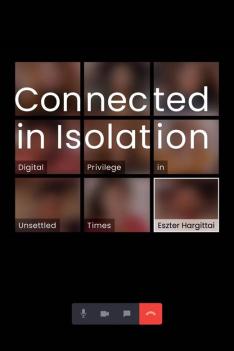
The book: For researchers, the pandemic offered a unique opportunity to study our society under a moment of unprecedented pressure. Connected in Isolation (MIT Press), focuses on the digital divide to understand its impact early in the pandemic when isolation measures were at their height and life literally continued online for many. Using survey data collected in April and May of 2020 in the United States, Italy, and Switzerland, the book explores how people took advantage of the internet during the pandemic, how it exacerbated inequalities for those who lacked the resources to stay connected, and ultimately the fundamental way the pandemic shifted society’s reliance on digital media.
The author: Eszter Hargittai *03 is a professor and chair of Internet Use & Society in the Department of Communication and Media Research at the University of Zurich. There she also heads the Web Use Project research group. Hargittai earned her undergraduate degree from Smith College and her Ph.D. from Princeton in sociology. Her research focuses on the social and policy implications of digital media. Hargittai’s writings on the subject have appeared in various publications including The New York Times and USA Today. She’s also the editor of four books, including the Handbook of Digital Inequality.
Excerpt:
Before diving deep into how people used digital media in 2020 to man-age life under lockdown, this chapter sets the stage for how people were coping more broadly during the pandemic’s early weeks. After giving a quick time line of events in the three countries explored in this book, the discussion moves on to examining people’s main worries, changes in their home circumstances including childcare responsibilities when applicable, and changes in employment. Then it considers people’s confidence in institutions such as the medical system and the federal government to handle the pandemic. The final section looks at people’s knowledge of COVID-19 and what misconceptions they had about it, which will feature prominently throughout the book in relation to people’s digital media uses.
Although implemented to varying degrees, most governments and public health institutions worldwide set physical distancing and stay-at-home guide-lines to prevent the spread of the novel coronavirus in spring 2020.1Placeswhere individuals typically gather such as the workplace, schools, shops, restaurants, bars, cafés, cultural venues, houses of worship, sports establishments, and beauty salons were often closed to minimize public health threats. The extraordinary stay-at-home circumstances made for fewer opportunities to meet in person, and thus many of the ways in which people connect socially were no longer available. Indeed, analysis of cell phone data showed substantial increases in physical distancing among Americans during the first months of the pandemic.
Italy was the first country outside of Asia to go into lockdown. Although research late in 2020 suggested that the new coronavirus was already circulating in the country in fall 2019, it was not until 2020 that people were diagnosed with it. The first confirmed cases in Italy occurred in January when two Chinese tourists tested positive in Rome. By the end of February, several small northern Italian towns saw outbreaks with the first death occurring on February 22. Increasing restrictions were placed on the region followed by nationwide lockdowns on March 9.
Lockdowns in Italy were more severe than those implemented in many other countries in the weeks and months to follow. For example, going outside for a run could only be done near one’s residence and people were not allowed to travel around the country at all. As the first hot spot of cases outside of China, Italy received much attention at the time and makes for an interesting case of lockdown circumstances both for being the first country in the West to experience it and due to the relative severity of restrictions put on people’s mobility there.
The southern part of Switzerland borders northern Italy, precisely the part of that country that was hardest hit by COVID-19 from the start. Cases started rising quickly in Switzerland’s Italian-speaking border regions due to many connections between those neighboring areas, such as workers crossing from one to the other as part of their daily commutes. Indeed, the first documented case in Switzerland occurred in the Italian-speaking canton of Ticino on February 24, 2020, with a seventy-year-old man who had contracted the virus while participating in a demonstration in northern Italy. Several other initial cases in Switzerland were linked to movement across the Italian border.
Despite the significant rise in infections, Swiss authorities did not start limiting border crossings until March 12 and did not close borders to Italy (and other countries) entirely until March 18. As cases surpassed the 2,000 mark, accompanied by thirteen deaths, the Federal Council announced nationwide lockdowns starting March 16. While schools and many businesses closed, restrictions were never as severe as in Italy.
Infections were reported in the United States even earlier. The first confirmed case was in Washington state on January 20, 2020. A 30-year-old man had developed symptoms after returning from a trip to Wuhan, China. The first death occurred in Seattle on February 29 with nineteen deaths across the United States a week later. The first states to close their schools were Washington and New Mexico on March 13 when there were 2,163 cases nationwide and already forty-nine deaths had occurred. Many other states closed their schools by Monday of the following week, March16. The first stay-at-home order came in California on March 19, with several others following suit in the coming days. New York City was another area of the country hit relatively early.
Given initial infections in cities, the more rural regions of the United States may not have been as alarmed at first. The United States is much larger in geographic distribution and population than Italy and Switzerland, so the spread of the virus was more concentrated in certain areas at first, although by the third week in March all states had several confirmed cases. There was never a nationwide stay-at-home order, such guidelines being instituted at the local or state level instead. All but nine states (eight of them with Republican governors) had such orders by April, with those nine states making up just 7.5% of the US population. A month later, just seven states (six with Republican governors) or 4.3% of the country’s population had no such orders.
Sheltering in Place
At the time of this study in April 2020, most areas surveyed were under lockdown or stay-at-home guidelines. Figure 1.1 shows how seriously people abided by these measures in the three countries based on their responses to the survey. It is clear from these graphs that Italy was experiencing a hard lockdown compared to softer approaches in the other two nations. Although it continued to be widespread for most people to go out for buying groceries and going to the doctor or pharmacy remained relatively common in all three nations, Italians were much more limited in their mobility in most other ways. Americans were most likely to go shopping beyond groceries or eat out, while the Swiss were most likely to go to work and meet up with friends. They were also the most likely to go out for exercise. Again, the small numbers for that activity in Italy show just how serious the lockdown measures were. Indeed, 12% reported not having left their home for any activities at all, a figure that was much smaller in the United States (6%) and Switzerland (4%).
Aggregating the reasons people left home, only 4% of Italians did so for any nonessential activities (that is, meeting up with friends; going out to eat; going out for beauty or personal care services; going to a place of worship, the movies, a theater, or a concert; and going to a bar or café). Leaving the home for other-than-essential tasks was considerably more common in the other two countries: 23% in the United States and 22% in Switzerland. In all three countries, younger people and those with disabilities were more likely to do this. (These statistical analyses controlled for other sociodemographics such as gender and education as well as whether the respondent lived alone and/or had children in the household. In the United States, the analyses also controlled for whether the state had stay-at-home orders in place.)
Excerpted from Connected in Isolation by Eszter Hargittai. Used by permission of the publisher, The MIT Press. All rights reserved.
Reviews:
“Connected in Isolation is a remarkable portrait of digital divides operating in real time, with immediate, measurable consequences on health, job, and life outcomes. By seizing the pandemic as a research opportunity, Hargittai and her team show us the multiple facets of spreading digital inequality, spotlighting the need for an entire set of policies that build on broadband access to create genuine digital opportunity.” — Anne-Marie Slaughter ’80, CEO, New America
“Connected in Isolation provides both a vivid snapshot of the inequities of life during the Covid-19 global pandemic and an invitation to envision building societal resilience in preparation for future crises.” — Danah Boyd, author of It’s Complicated: The Social Lives of Networked Teens

